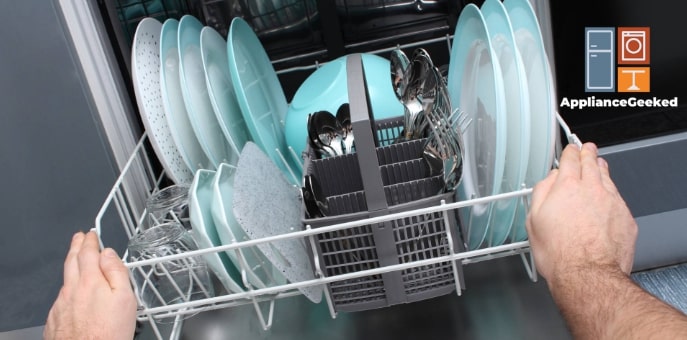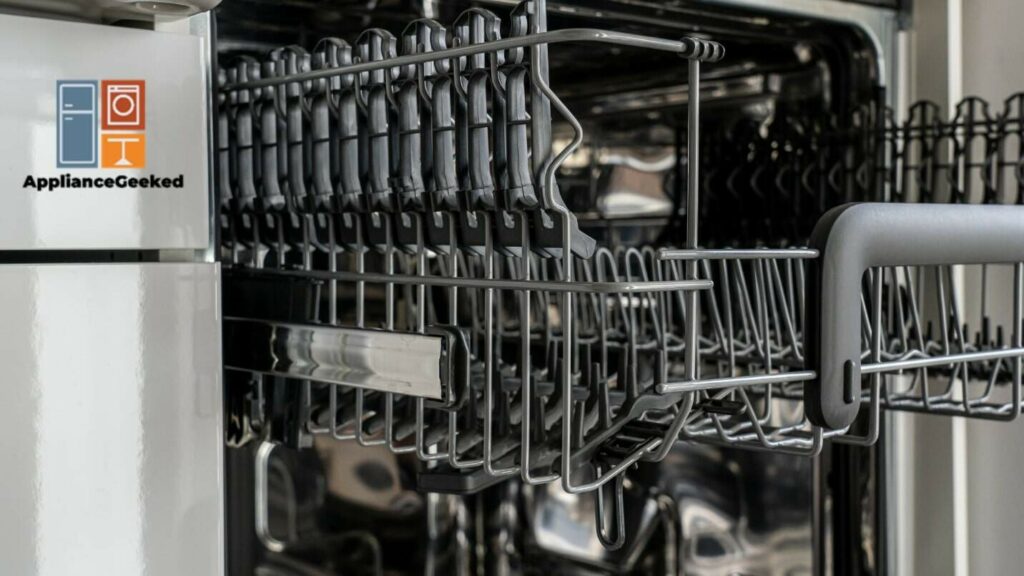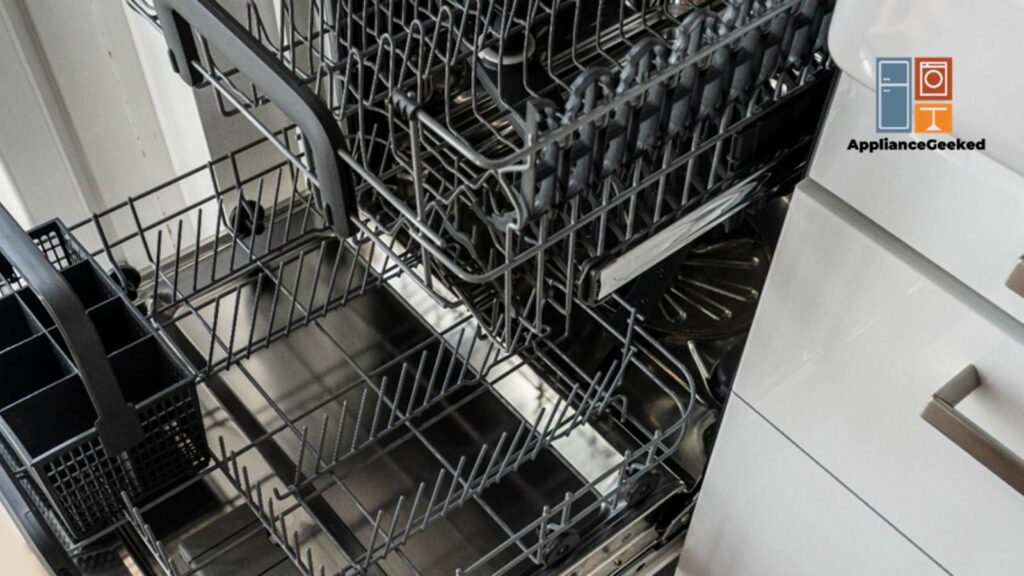It’s common for your dishwasher to make noise while running. However, a loud grinding sound can be quite harmful to your appliance.
So why is your dishwasher making a grinding sound and what can you do to fix it? Let’s dive right into it.
Why is your dishwasher making a grinding noise?
Your dishwasher will make a grinding noise if there’s debris in the tub or impellers. A broken pump bearing, inlet valve, or food grinder can also be the cause.
To fix, unplug the dishwasher and clean the interior walls. Inspect the pump’s impeller and motor bearings for damage. Replace them if needed.
If the grinding sound is still present, try the following steps:
- Remove the water inlet valve and check it for damage. Replace the valve if the diaphragm is deformed.
- Inspect the food grinder and make sure it isn’t broken. Replace the grinder plate assembly if it isn’t spinning correctly or has signs of damage.
Do you need more to go on? Continue reading below for detailed instructions on how to perform these steps.
Important Note: Before you perform any of the repairs, make sure to unplug your dishwasher first and turn off the water supply valve to avoid injury.
Causes and Solution
There are 6 possible reasons your dishwasher is making a grinding noise.
- There is debris in the tub.
- The impellers are clogged.
- The pump bearings are damaged.
- The water inlet valve is faulty.
- The food grinder is clogged or broken.
With that in mind, here’s a quick overview of how to fix these issues.
| Causes | Solutions |
| Debris Inside the Tub | Remove your loaded items and pull out the dishwasher racks. Wipe the tub using a clean cloth soaked in hot water. Make sure to remove any debris such as pieces of bone, glass, and plastic stuck on the interior walls or the bottom of the tub. |
| Clogged Impellers | Check the impellers for clogs and clean them with a soft brush. Also, test whether the impellers can move freely or not and replace them if necessary. |
| Damaged Drain Pump | Uninstall the drain pump and clean it thoroughly. Remove any foreign debris that may have been wedged inside its motor. Inspect the drain pump’s bearing for any signs of damage. Replace the bearings if they are broken or too rusty. |
| Faulty Water Inlet Valve | Pull out the mesh filter from inside the water inlet valve. Clean it using a soft brush under running water. Look for signs of damage in the water inlet valve’s diaphragm. Replace the valve assembly if it’s damaged. |
| Broken Food Grinder | Check the grinder for clogs or damages. If the grinder is faulty or broken, call a professional to fix it or replace the grinder plate entirely. |
Now, we’ll dive a little deeper into these errors and give you step-by-step instructions on how to perform each repair.
Debris Inside the Tub
One of the common reasons your dishwasher is making a grinding noise is that there is hard debris inside your tub.
This can be a broken piece of glass, plastic, or bone at the bottom of your dishwasher.
As water is sprayed and runs inside your dishwasher, the debris grinds aggressively against the stainless steel wall of the tub, causing the noise.
Solution: First, unplug your dishwasher and make sure that there’s no residual power left by pressing the power button.
Remove all your washables, pull out the racks and baskets, and set them aside. Wipe the interior wall of your dishwasher thoroughly using a clean cloth soaked in hot water.
Make sure to remove any residual food and other debris. Wash the racks and baskets before putting them back inside your dishwasher.
Clogged Impellers
Most dishwashers have two impellers that facilitate the flow of water inside your machine.
One is attached to the circulation pump and pushes water strongly into the spray arms. The second impeller is located at the drain pump and forces wastewater out to the drain hose.
Debris stuck in one of the impellers could grind against the impeller while it is spinning.
Not only will this produce the noise you’re hearing, but this will also affect the water level inside your dishwasher.
Solution: Remove the entire pump assembly to access the impellers. Clean the impellers using a soft brush and make sure that there is no debris stuck in between.
Test the impellers to verify that they can move freely. Take note that a working impeller will have a jerky motion when you try to spin it with your fingers.
However, if the impeller has visible signs of damage or doesn’t spin correctly, call an expert to have it fixed or replaced.
Damage Drain Pump
Another likely cause of the grinding noise in your dishwasher is a damaged drain pump motor.
The drain pump powers the impeller to push water out of your dishwasher and up the drain hose. It spins the impeller with enough force to prevent wastewater from flowing back to your tub.
Because of this, the drain pump’s bearings are very vulnerable to wear and tear.
When they become damaged, unlubricated, or rusty, they will produce a loud grinding sound while the drain cycle is on.
Solution: First, read your manual and check where the drain pump can be accessed in your dishwasher.
While some dishwasher models install their drain pump just below the filter assembly, others can be accessed from the bottom panel of your dishwasher.
If it’s the former, follow these steps to remove the filter assembly and access the drain pump.
- Step 1: Unplug your dishwasher and turn off the water supply valve. Make sure that there is no more residual power by pressing the power button and checking if the panel lights up
- Step 2: Open the dishwasher door and remove the lower rack.
- Step 3: Hold the spray arm in place and turn the filter assembly counterclockwise.
- Step 4: Slowly pull the entire filter assembly out to access the drain pump.
- Step 5: Uninstall the drain pump from its housing and inspect it. Test the pump motor and solenoids to make sure that it’s working correctly.
- Step 6: Replace the drain pump assembly if it’s damaged.
If it’s the latter, follow these steps to remove your drain pump assembly:
- Step 1: First, unplug your dishwasher.
- Step 2: Turn off the water supply valve.
- Step 3: Unscrew the bottom kick panel and remove it. Set the panel aside for later.
- Step 4: Place a towel or pan underneath to catch spills. Disconnect the water supply line from the inlet valve using a 5/8th inch wrench.
- Step 5: Unscrew the junction box cover and take it off. Take note of the location of the wires so you won’t be confused when reconnecting them later.
- Step 6: Untwist the wire nut and disconnect the wires.
- Step 7: Unthread the strain relief nut and detach it from the junction box.
- Step 8: Disconnect the drain hose from the garbage disposal or the sink drain. Feed the hose through the cabinet hole to pull the dishwasher out.
- Step 9: Pull your dishwasher out of the cabinet carefully. Adjust the leveling legs down if necessary by turning the adjustment rod clockwise.
- Step 10: Slowly tip the machine back so that it’s resting on its rear panel. Make sure not to damage the drain hose while tilting your dishwasher.
- Step 11: Unscrew the access panel and remove it. Disconnect the leak sensor wire connector and set the panel aside.
- Step 12: Lift the locking tab using a small flathead screwdriver. Slightly turn the drain pump counterclockwise to detach it.
- Step 13: Disconnect the wires from the old drain pump to remove it completely.
- Step 14: Check the drain motor’s bearings. Replace the drain pump assembly if the bearings are deformed, broken, or too rusty.
- Step 15: Install your new drain pump into the chamber and connect the wires. Make sure to place it correctly and rotate it clockwise to secure it.
- Step 16: Reinstall everything back in place by retracing the steps above.
Faulty Water Inlet Valve
The water inlet valve filters and regulates the water coming into your dishwasher.
However, if you have a hard water supply in your home, the minerals could damage the mesh filter and deform the diaphragm of the inlet valve over time.
Foreign debris from your water supply is also a possible cause of the damage.
When this happens, the water inlet valve will produce a loud grinding or buzzing noise as the hard water passes through it.
Solution: Uninstall your water inlet valve for inspection. To do this, follow the steps below:
- Step 1: Unplug your dishwasher. Press the power button and make sure it doesn’t light up.
- Step 2: Remove the kick panel below the dishwasher to access the water inlet valve.
- Step 3: Detach the wires connected to it using a pair of pliers.
- Step 4: Pull out the mesh filter and check it for damage. If the filter is still in working condition, clean it in running water.
- Step 5: Clean any food residue or debris in the inlet valve without disassembling it.
- Step 6: Check the inlet valve’s diaphragm for any signs of damage or deformities. Replace the inlet valve if it’s worn out.
Consider installing a water softening system in your household. This will help combat hard water issues and prolong the lifespan of your dishwasher.
Broken Food Grinder
Older dishwasher models use a grinder plate or food chopper to break down larger leftover food that may have escaped the filters.
However, some brands no longer have this component because it produces too much noise during the cycle.
If your model has it, this may be the cause of the grinding noise you’re hearing from your dishwasher. The sound will also get much louder if the grinder plate is broken.
Solution: First, read your dishwasher’s manual and locate the food grinder plate.
If your grinder plate is located underneath the filter assembly like most models, follow the steps below to remove it.
- Step 1: Unplug your dishwasher and turn off the water supply valve.
- Step 2: Remove the lower dish rack and uninstall the water spray arm.
- Step 3: Uninstall the filter assembly and take it out.
- Step 4: Unscrew the foreign object protector and remove it.
- Step 5: Remove the pump inlet protector by unthreading the screws.
- Step 6: Use a flathead screwdriver to push the food grinder assembly out from the central pin.
- Step 7: Inspect the food grinder for damages and replace it if necessary.
With enough tools and handyman skills, these errors can be DIYed by simply following the steps above.
However, if some of these steps are a little out of your comfort zone, don’t hesitate to call a professional for help.




